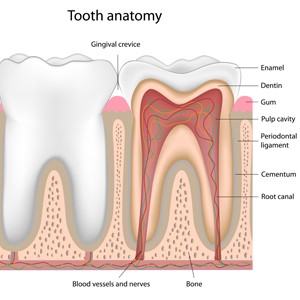 By studying the anatomy of a tooth and learning about the functions of the many structures, we can better understand the basics of maintaining good oral health and why it is so important to avoid cavities.
By studying the anatomy of a tooth and learning about the functions of the many structures, we can better understand the basics of maintaining good oral health and why it is so important to avoid cavities.
Let’s take a look at…
The crown is the part of the tooth you see when you look in your mouth. The crowns of your back teeth have pointed cusps and depressions. When you chew, the cusps of the teeth in one jaw fit into the depressions of the teeth in the other jaw.
The root portion of a tooth anchors the tooth in the jawbone. It is hidden by gums. The root makes up about two thirds of the total length of the tooth. Looking a little further into the tooth, let’s examine the tissues of a tooth.
The enamel is the hard outer covering of the crown of the tooth. It helps to keep the tooth from being worn away by the forces of chewing. It is the hardest tissue in the body.
The dentin is a bone-like tissue that lies underneath the enamel and supports it. The dentin forms the bulk of the tooth.
The pulp is a soft tissue that contains nerves, blood vessels and lymph vessels. It lies within the dentin, at the center of the crown and the root.
The cementum is a thin, bone-like tissue that covers the root of the tooth.
The periodontal ligament is a layer of tissue that connects the root to the jawbone. It stretches between the cementum and the bond around the tooth.
Now that we’ve reviewed the anatomy of a tooth, let’s concentrate on the best way to keep the teeth healthy and cavity free. The key to that is simply brushing and flossing daily.
Property cleansing of the teeth removes plaque, which is a soft, sticky, colorless film of bacteria that is constantly forming on your teeth. When you eat food that contains carbohydrates (sugars and starches), the bacteria in plaque produce acids that can destroy tooth enamel. In addition to the acids, other irritating byproducts are produced. The irritants inflame the gums, make them tender and likely to bleed. Eventually, the irritated gums pull away from the teeth, leaving deep pockets that become filled with bacteria. If the disease is not treated, healthy teeth become loose and may have to be removed.
With all this said, there is still no reason why we cannot substantially reduce or eliminate dental disease. All it takes is some common sense, proper instruction, and your promise to yourself to do your part in keeping your mouth clean and free of plaque. Preventing dental problems before they develop is still the best way to keep a healthy smile!
